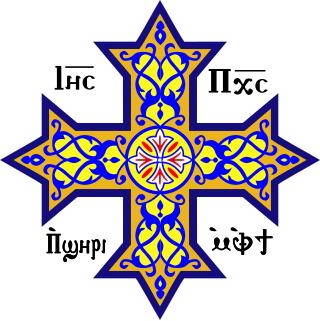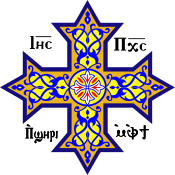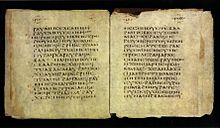
The Egyptian language, or Ancient Egyptian is an extinct branch of the Afro-Asiatic languages that was spoken in ancient Egypt. It is known today from a large corpus of surviving texts, which were made accessible to the modern world following the decipherment of the ancient Egyptian scripts in the early 19th century.

Coptic is an Afroasiatic dormant language. It is a group of closely related Egyptian dialects, representing the most recent developments of the Egyptian language, and historically spoken by the Copts, starting from the third century AD in Roman Egypt. Coptic was supplanted by Arabic as the primary spoken language of Egypt following the Arab conquest of Egypt and was slowly replaced over the centuries.
The Coptic alphabet is the script used for writing the Coptic language, the most recent development of Egyptian. The repertoire of glyphs is based on the uncial Greek alphabet, augmented by letters borrowed from the Egyptian Demotic. It was the first alphabetic script used for the Egyptian language. There are several Coptic alphabets, as the script varies greatly among the various dialects and eras of the Coptic language.

The Epistle of the Apostles is a work of New Testament apocrypha. Despite its name, it is more a gospel or an apocalypse than an epistle. The work takes the form of an open letter purportedly from the remaining eleven apostles describing key events of the life of Jesus, followed by a dialogue between the resurrected Jesus and the apostles where Jesus reveals apocalyptic secrets of reality and the future. It is 51 chapters long. The epistle was likely written in the 2nd century CE in Koine Greek, but was lost for many centuries. A partial Coptic language manuscript was discovered in 1895, a more complete Ethiopic language manuscript was published in 1913, and a full Coptic-Ethiopic-German edition was published in 1919.

Shenoute of Atripe, also known as Shenoute the Great or Saint Shenoute the Archimandrite, was the abbot of the White Monastery in Egypt. He is considered a saint by the Oriental Orthodox Churches and is one of the most renowned saints of the Coptic Orthodox Church.
Coptic pronunciation reform, since 1850, has resulted in two major shifts in the liturgical pronunciation of Bohairic, the dialect of Coptic used as the language of the Coptic Orthodox Church. Since Coptic had ceased to be spoken as a mother-tongue by this time, a change in education changed how the language was spoken. The two traditions of pronunciation in contemporary use arise from two successive reforms in the 19th and 20th centuries:

The Coptic White Monastery, also The Monastery of Abba Shenouda and The Athribian Monastery is a Coptic Orthodox monastery named after Saint Shenoute. It is located near the Upper Egyptian cities of Tahta and Sohag, and about two and a half miles (4.0 km) south-east of the Red Monastery.

The Dishna Papers, also often known as the Bodmer Papyri, are a group of twenty-two papyri discovered in Dishna, Egypt in 1952. Later, they were purchased by Martin Bodmer and deposited at the Bodmer Library in Switzerland. The papyri contain segments from the Old and New Testaments, early Christian literature, Homer, and Menander. The oldest, P66 dates to c. 200 AD. Most of the papyri are kept at the Bodmer Library, in Cologny, Switzerland outside Geneva.

There have been many Coptic versions of the Bible, including some of the earliest translations into any language. Several different versions were made in the ancient world, with different editions of the Old and New Testament in five of the dialects of Coptic: Bohairic (northern), Fayyumic, Sahidic (southern), Akhmimic and Mesokemic (middle). Biblical books were translated from the Alexandrian Greek version.

Theodorus of Tabennese, also known as Abba Theodorus and Theodore the Sanctified, was the spiritual successor to Pachomius and played a crucial role in preventing the first Christian cenobitic monastic federation from collapsing after the death of its founder.
George William Horner (1849–1930) was a British biblical scholar, an editor of the text of the New Testament in the dialects of the Coptic language.
The Alexandrine Sinodos is a Christian collection of Church Orders. This collection of earlier texts dates from the 4th or 5th century CE. The provenance is Egypt and it was particularly used in the ancient Coptic and Ethiopian Christianity.
al-Qasr wa as-Sayyad is a village in Nag Hammadi district of Qena Governorate, Egypt.

Alin Suciu is a Romanian coptologist and papyrologist. He is a Senior Researcher at the Göttingen Academy of Sciences and Humanities and a Docent in Early Christian Literature and Coptic Christianity at the Faculty of Theology, University of Helsinki.
There are no original works of philosophy in the Coptic language. All surviving philosophical passages in Coptic are of Greek origin and many are anonymous. Mostly they deal with ethics and are treated like wisdom literature. Only a few texts have been edited and published.
Bohairic is a dialect of the Coptic language, the latest stage of the Egyptian language. Bohairic is attested from the eighth century CE, and has been the chief liturgical language of the Coptic Orthodox Church since the eleventh century.
Athanasius of Qus was a Coptic monk, bishop and scholar. He was a leader of the church in Upper Egypt and Lower Nubia. He wrote in both Arabic and Coptic. His works include theology, Coptic grammar and poetry. His primary dialect was Sahidic.

Old Coptic is the earliest stage of Coptic writing, a form of late Egyptian written in the Coptic script, a variant of the Greek alphabet. It "is an analytical category … utilised by scholars to refer to a particular group of sources" and not a language, dialect or singular writing system. Scholars differ on the exact boundaries of the Old Coptic corpus and thus on the definition of "Old Coptic". Generally, it can be said that Old Coptic texts use more letters of Demotic derivation than later literary Coptic. They lack the consistent script style and borrowed Greek vocabulary of later Coptic literature. Some even use exclusively Greek letters. Moreover, they are generally or exclusively of Egyptian pagan origin, as opposed to later literary Coptic texts, which are strongly associated with Coptic Christianity and to a lesser extent Gnosticism and Manichaeism.

Early translations of the New Testament – translations of the New Testament created in the 1st millennium. Among them, the ancient translations are highly regarded. They play a crucial role in modern criticism of New Testament's text. These translations reached the hands of scholars in copies and also underwent changes, but the subsequent history of their text was independent of the Greek text-type and are therefore helpful in reconstructing it. Three of them – Syriac, Latin, Coptic – date from the late 2nd century and are older than the surviving full Greek manuscripts of the New Testament. They were written before the first revisions of the Greek New Testament and are therefore the most highly regarded. They are obligatorily cited in all critical editions of the Greek text-type. Translations produced after 300 are already dependent on the reviews, but are nevertheless important and are generally cited in the critical apparatus. The Gothic and Slavic translations are rarely cited in critical editions. Omitted are those of the translations of the first millennium that were not translated directly from the Greek original, but based on another translation.















